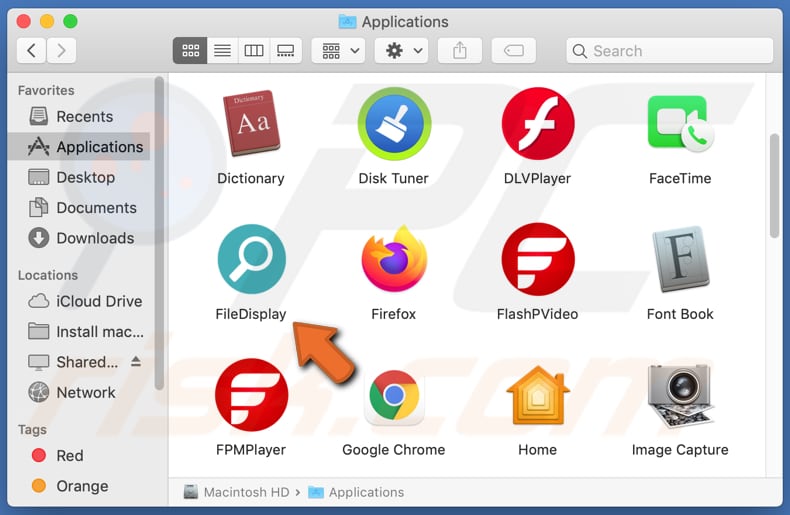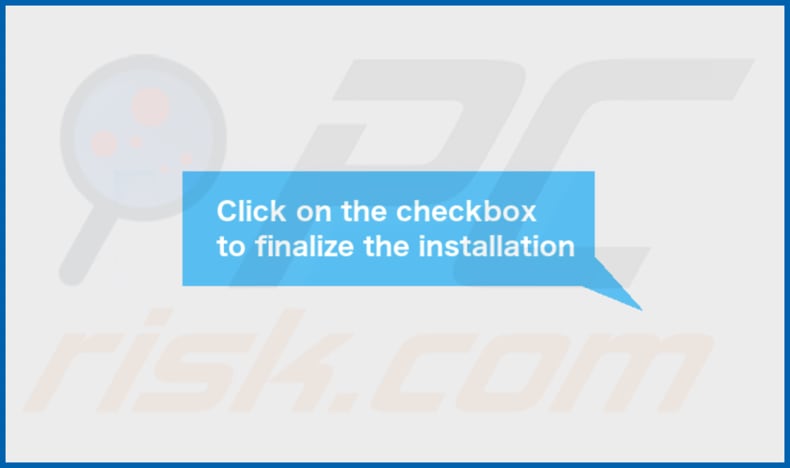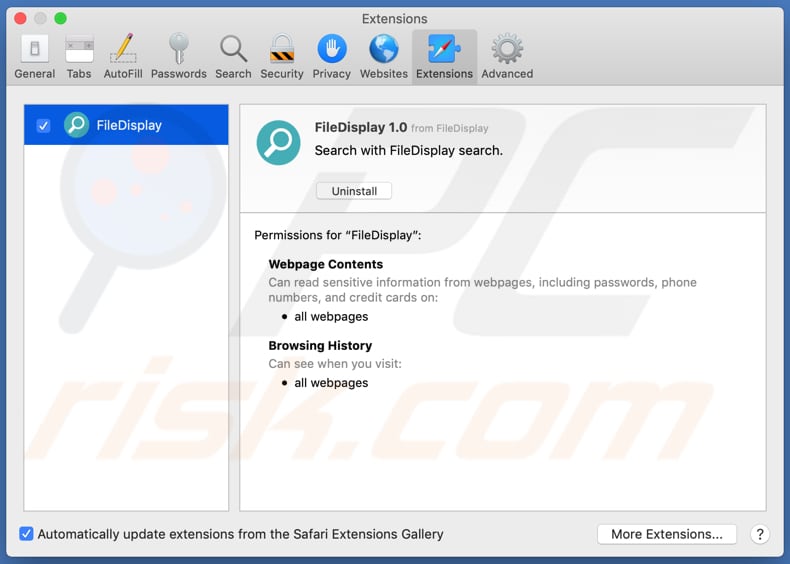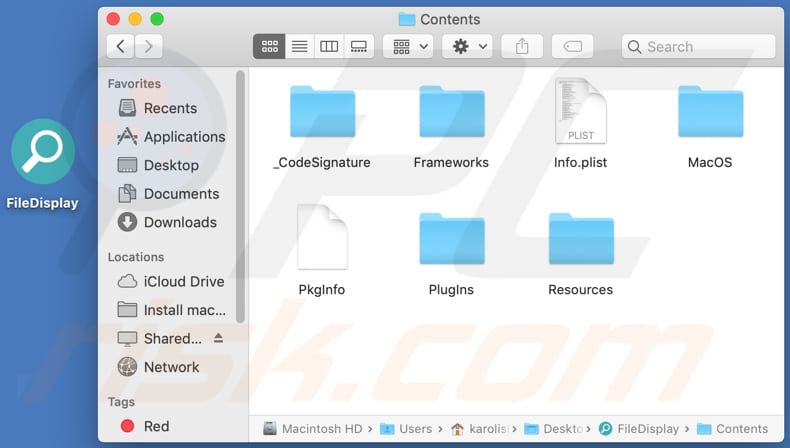Get free scan and check if your device is infected.
Remove it nowTo use full-featured product, you have to purchase a license for Combo Cleaner. Seven days free trial available. Combo Cleaner is owned and operated by RCS LT, the parent company of PCRisk.com.
What is FileDisplay?
It is common for adware to be downloaded and installed unknowingly. For this reason, FileDisplay and other applications of this kind are called potentially unwanted applications (PUAs).
FileDisplay generates unwanted advertisements, changes browser's settings to promote a fake search engine (its address) and collects sensitive data. It is worth mentioning that apps that promote fake search engines by modifying browser's settings are categorized as browser hijackers.

Usually, adware displays pop-ups, coupons, banners, surveys, and other ads designed to open questionable websites or download (sometimes, install) unwanted applications by running certain scripts. It is noteworthy that ads generated by apps like FileDisplay often cover website contents and slow down computers or other affected devices.
In one way or another, it is highly advisable not to click ads generated by adware or have software of this type installed on a browser or the operating system (including FileDisplay). The second reason not to have FileDisplay installed is that this PUA changes the browser's settings: it changes the address of a default search engine, homepage, and new tab to an address of some fake search engine.
In other words, FileDisplay is designed to force its users to use a fake search engine to browse the web. Typically, fake search engines show results generated by Yahoo, Google, Bing, or other legitimate search engines, or they show results that are likely to include questionable websites.
Either way, it is recommended to use only legitimate search engines. Quite often, users of hijacked browsers cannot remove a fake search engine (its address) from settings unless they uninstall a browser hijacker.
The third reason not to trust FileDisplay is that it can read sensitive information. It is known that this app can access passwords, phone numbers, credit card details, and other data that could be sold to third parties (potentially cybercriminals), used for marketing purposes, to steal online accounts, make fraudulent purchased, transactions, etc.
Therefore, when users have apps like FileDisplay installed on their browsers or computers, they are at risk of becoming victims of identity theft, losing money and access to personal accounts (e.g., email, social media, banking accounts), encountering problems related to online privacy, browsing safety, and other issues. It is noteworthy that apps of this kind are often designed to gather browsing data like IP addresses/geolocations, visited websites (their addresses), entered search queries, and other details of this type.
| Name | Ads by FileDisplay |
| Threat Type | Adware, Mac malware, Mac virus |
| Detection Names | Avast (MacOS:Adload-AG [Adw]), AVG (MacOS:Adload-AG [Adw]), ESET-NOD32 (A Variant Of OSX/Adware.Synataeb.F), Kaspersky (Not-a-virus:HEUR:AdWare.OSX.Adload.h), Full List (VirusTotal) |
| Additional Information | This application belongs to Adload malware family. |
| Symptoms | Your Mac becomes slower than normal, you see unwanted pop-up ads, you are redirected to dubious websites. |
| Distribution methods | Deceptive pop-up ads, free software installers (bundling), fake Flash Player installers, torrent file downloads. |
| Damage | Internet browser tracking (potential privacy issues), display of unwanted ads, redirects to dubious websites, loss of private information. |
| Malware Removal (Windows) |
To eliminate possible malware infections, scan your computer with legitimate antivirus software. Our security researchers recommend using Combo Cleaner. Download Combo CleanerTo use full-featured product, you have to purchase a license for Combo Cleaner. 7 days free trial available. Combo Cleaner is owned and operated by RCS LT, the parent company of PCRisk.com. |
There are many examples of adware-type applications. A couple of them are AccessibilityDock, Helper_update, and ElementarySignalSearch.
Apps of this type may appear legitimate. However, most of them are useless and can be the culprit of various problems. Typically, the main purpose of adware is to generate revenue for its developer by displaying advertisements.
Although, apps like FileDisplay have additional functionalities: they change web browser's settings and collect data. In one way or another, it is strongly recommended not to have FileDisplay or any other adware-type application installed on the operating system or a web browser.
How did FileDisplay install on my computer?
It is common for browser hijackers, adware, and other potentially unwanted applications to be distributed by including them as additional offers in downloaders or installers for other programs. This distribution method is known as "bundling". In most cases, users can find and opt out bundled applications using "Advanced", "Custom", "Manual" or other settings, or by unticking ticked checkboxes.
Users accept offers to download or install included applications when they do not change the aforementioned settings. Sometimes, potentially unwanted apps are distributed using advertisements. In such cases, users cause unexpected downloads or installations by clicking advertisements designed to execute certain scripts.
How to avoid installation of potentially unwanted applications?
Applications should be downloaded from trustworthy, official web pages. It is not recommended to download them (or files) from unofficial pages, via third-party downloaders, Peer-to-Peer networks like torrent clients, eMule, etc.
It is common that the aforementioned sources are used to distribute potentially unwanted or malicious apps. Third-party, unofficial installers can be malicious too. Furthermore, downloaders and installers with settings like "Custom", "Advanced" (or checkboxes) are likely to include unwanted offers.
Therefore, downloads and installations should be finished when all settings/options are checked, and unwanted offers declined. Advertisements appearing on untrustworthy websites (e.g., on pages related to pornography, gambling, adult dating) should not be clicked as well.
It is common for those ads to be used to promote various untrustworthy, potentially malicious websites or distribute PUAs. Unwanted, suspicious apps (extensions, plug-ins, add-ons) installed on a web browser and applications of this kind installed on the operating system should be removed.
If your computer is already infected with FileDisplay, we recommend running a scan with Combo Cleaner Antivirus for Windows to automatically eliminate this adware.
Pop-up window displayed once FileDisplay installation is over:

FileDisplay adware installed on Safari browser:

FileDisplay's Contents folder:

Instant automatic malware removal:
Manual threat removal might be a lengthy and complicated process that requires advanced IT skills. Combo Cleaner is a professional automatic malware removal tool that is recommended to get rid of malware. Download it by clicking the button below:
DOWNLOAD Combo CleanerBy downloading any software listed on this website you agree to our Privacy Policy and Terms of Use. To use full-featured product, you have to purchase a license for Combo Cleaner. 7 days free trial available. Combo Cleaner is owned and operated by RCS LT, the parent company of PCRisk.com.
Quick menu:
- What is FileDisplay?
- STEP 1. Remove FileDisplay related files and folders from OSX.
- STEP 2. Remove FileDisplay ads from Safari.
- STEP 3. Remove FileDisplay adware from Google Chrome.
- STEP 4. Remove FileDisplay ads from Mozilla Firefox.
Video showing how to remove adware and browser hijackers from a Mac computer:
FileDisplay adware removal:
Remove FileDisplay-related potentially unwanted applications from your "Applications" folder:

Click the Finder icon. In the Finder window, select "Applications". In the applications folder, look for "MPlayerX", "NicePlayer", or other suspicious applications and drag them to the Trash. After removing the potentially unwanted application(s) that cause online ads, scan your Mac for any remaining unwanted components.
DOWNLOAD remover for malware infections
Combo Cleaner checks if your computer is infected with malware. To use full-featured product, you have to purchase a license for Combo Cleaner. 7 days free trial available. Combo Cleaner is owned and operated by RCS LT, the parent company of PCRisk.com.
Remove adware-related files and folders

Click the Finder icon, from the menu bar. Choose Go, and click Go to Folder...
 Check for adware generated files in the /Library/LaunchAgents/ folder:
Check for adware generated files in the /Library/LaunchAgents/ folder:

In the Go to Folder... bar, type: /Library/LaunchAgents/

In the "LaunchAgents" folder, look for any recently-added suspicious files and move them to the Trash. Examples of files generated by adware - "installmac.AppRemoval.plist", "myppes.download.plist", "mykotlerino.ltvbit.plist", "kuklorest.update.plist", etc. Adware commonly installs several files with the exact same string.
 Check for adware generated files in the ~/Library/Application Support/ folder:
Check for adware generated files in the ~/Library/Application Support/ folder:

In the Go to Folder... bar, type: ~/Library/Application Support/

In the "Application Support" folder, look for any recently-added suspicious folders. For example, "MplayerX" or "NicePlayer", and move these folders to the Trash.
 Check for adware generated files in the ~/Library/LaunchAgents/ folder:
Check for adware generated files in the ~/Library/LaunchAgents/ folder:

In the Go to Folder... bar, type: ~/Library/LaunchAgents/

In the "LaunchAgents" folder, look for any recently-added suspicious files and move them to the Trash. Examples of files generated by adware - "installmac.AppRemoval.plist", "myppes.download.plist", "mykotlerino.ltvbit.plist", "kuklorest.update.plist", etc. Adware commonly installs several files with the exact same string.
 Check for adware generated files in the /Library/LaunchDaemons/ folder:
Check for adware generated files in the /Library/LaunchDaemons/ folder:

In the "Go to Folder..." bar, type: /Library/LaunchDaemons/

In the "LaunchDaemons" folder, look for recently-added suspicious files. For example "com.aoudad.net-preferences.plist", "com.myppes.net-preferences.plist", "com.kuklorest.net-preferences.plist", "com.avickUpd.plist", etc., and move them to the Trash.
 Scan your Mac with Combo Cleaner:
Scan your Mac with Combo Cleaner:
If you have followed all the steps correctly, your Mac should be clean of infections. To ensure your system is not infected, run a scan with Combo Cleaner Antivirus. Download it HERE. After downloading the file, double click combocleaner.dmg installer. In the opened window, drag and drop the Combo Cleaner icon on top of the Applications icon. Now open your launchpad and click on the Combo Cleaner icon. Wait until Combo Cleaner updates its virus definition database and click the "Start Combo Scan" button.

Combo Cleaner will scan your Mac for malware infections. If the antivirus scan displays "no threats found" - this means that you can continue with the removal guide; otherwise, it's recommended to remove any found infections before continuing.

After removing files and folders generated by the adware, continue to remove rogue extensions from your Internet browsers.
Remove malicious extensions from Internet browsers
 Remove malicious Safari extensions:
Remove malicious Safari extensions:

Open the Safari browser, from the menu bar, select "Safari" and click "Preferences...".

In the preferences window, select "Extensions" and look for any recently-installed suspicious extensions. When located, click the "Uninstall" button next to it/them. Note that you can safely uninstall all extensions from your Safari browser - none are crucial for regular browser operation.
- If you continue to have problems with browser redirects and unwanted advertisements - Reset Safari.
 Remove malicious extensions from Google Chrome:
Remove malicious extensions from Google Chrome:

Click the Chrome menu icon ![]() (at the top right corner of Google Chrome), select "More Tools" and click "Extensions". Locate all recently-installed suspicious extensions, select these entries and click "Remove".
(at the top right corner of Google Chrome), select "More Tools" and click "Extensions". Locate all recently-installed suspicious extensions, select these entries and click "Remove".

- If you continue to have problems with browser redirects and unwanted advertisements - Reset Google Chrome.
 Remove malicious extensions from Mozilla Firefox:
Remove malicious extensions from Mozilla Firefox:

Click the Firefox menu ![]() (at the top right corner of the main window) and select "Add-ons and themes". Click "Extensions", in the opened window locate all recently-installed suspicious extensions, click on the three dots and then click "Remove".
(at the top right corner of the main window) and select "Add-ons and themes". Click "Extensions", in the opened window locate all recently-installed suspicious extensions, click on the three dots and then click "Remove".

- If you continue to have problems with browser redirects and unwanted advertisements - Reset Mozilla Firefox.
Share:

Tomas Meskauskas
Expert security researcher, professional malware analyst
I am passionate about computer security and technology. I have an experience of over 10 years working in various companies related to computer technical issue solving and Internet security. I have been working as an author and editor for pcrisk.com since 2010. Follow me on Twitter and LinkedIn to stay informed about the latest online security threats.
PCrisk security portal is brought by a company RCS LT.
Joined forces of security researchers help educate computer users about the latest online security threats. More information about the company RCS LT.
Our malware removal guides are free. However, if you want to support us you can send us a donation.
DonatePCrisk security portal is brought by a company RCS LT.
Joined forces of security researchers help educate computer users about the latest online security threats. More information about the company RCS LT.
Our malware removal guides are free. However, if you want to support us you can send us a donation.
Donate
▼ Show Discussion